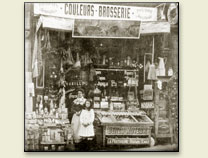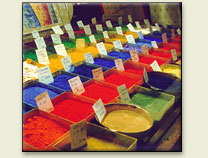A modern pigment shop in Venice, Italy, where the "traditional" painter can buy pigments to mix into paints themselves.

A turn-of-the-century merchant Mabille, who traded under the name Au rapin, c. 1905.
Paintings are made from mud and a stick with hairs...
Pigments are the basis of all paints, and have been used for millennia. They are ground colored material. Early pigments were simply as ground earth or clay, and were made into paint with spit or fat. Modern pigments are often sophisticated masterpieces of chemical engineering.
This exhibit includes most important pigments used through the early 20th century.
In a microscope, we see that paintings and other painted objects consist simply of pigments suspended in a substance – like chips in a chocolate chip cookie. The "substance" can vary, from oil or egg yolk in paintings, to plaster in frescos, or sophisticated plastics in automobile finishes. Moreover there are many interesting relationships between pigments (the focus of this exhibit) and dyes, and even with the "visual pigments" found in our own eyes.

